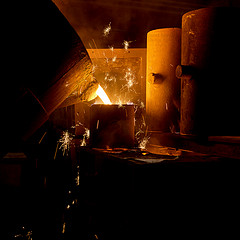Selecting a High Quality Sword
 You should already know what goes into a sword blade and that you should avoid stainless steel and floppy spring steel. If not, please speak with your instructor about it, or visit with us and we can give you a thorough introduction to metallurgy. The rest of your decision making process will deal primarily with the quality of the fittings, and their proper assembly. Here is a simple checklist you can use when selecting a sword.
You should already know what goes into a sword blade and that you should avoid stainless steel and floppy spring steel. If not, please speak with your instructor about it, or visit with us and we can give you a thorough introduction to metallurgy. The rest of your decision making process will deal primarily with the quality of the fittings, and their proper assembly. Here is a simple checklist you can use when selecting a sword.
- What kind of steel is it? For cheap swords that will never see contact or hard movements, stainless steel or floppy Asian spring steel is somewhat acceptable.
- What kind of temper has it had? A high quality sword should be differentially tempered.
- Is it too floppy, or too rigid? Too floppy and it is useless and even dangerous. Too rigid could make the blade prone to breaking.
- Where is the balance point of the sword? Ask for a rag (Never touch a blade. It is rude and skin oils may stain and cause tarnishing or accelerate rusting of the metal), place your hand under the rag, the sword over the rag and try to find where the balance point is. Then you decide if that is where you like it. Tai Chi straight sword balance should be within 4" in either direction of the guard.
- Hold the sword pointing upwards and, with the rag over your hand, moderately smack the side of the blade and feel for the harmonic vibrations. If it vibrates annoyingly in your hand, put it down and move on to another sword.
- Make sure you have plenty of room, and safely swing the sword (small movements are sufficient) and «feel» if it moves well for you (purely subjective). Do this with, and without the tassels. Tassels can give you a «fake„ feeling for the true overall balance of the sword. It is best to “feel» the sword without the tassels. Or, hold them up in the opposite hand.
- Hold the sword up and look down the entire length of the blade. Check that the blade is smooth and straight. You should NOT see waves or bumps. Some unscrupulous sales people will try to tell you this is the preferred proof that it is a quality hand–made sword. Not true. A poor quality machine made sword will have the same ripples. However, this does not necessarily mean the sword is junk. It just means it is not of the best manufacture.
- While holding the sword up, check for straightness. You do not want a bent blade.
- While holding the sword up check the alignment of the blade, the guard, the handle, and the pommel. They should all follow a straight line at every angle.
- 0. Flip the sword over and check for all of the above while looking at the other edge of the blade.
- 1. Check for a tight and well assembled blade collar (not all swords have one), guard, handle, and pommel. There should not be any large or unsightly cracks, gaps or spaces. Handle wraps should be tight and nothing should wiggle nor move.
- 2. If the owner of the sword allows you, and you are confident in your grip (if not, ask someone to help you), shake the blade violently (or a small harsh whipping motion) and feel for movement of the fittings, and for clicking sounds within the fittings. Little movements and clicking indicate poor assembly and future problems such as wrappings and handles falling apart or even breaking while in use.
- 3. Again, if the owner allows you and you are confident, hold the sword sideways (with a flat side of the blade facing you) and shake it violently (or a small harsh whipping motion). Feel and listen for problems. I actually did this with a sword with a price tag of about $1,400.00 and I heard two wood cracking sounds in the handle. I apologized and humbly asked the seller to please not make me buy the sword.
- 4. Lastly, check to see how the blade fits into the scabbard. It should be snug, but not so tight you cannot pull the blade out. However, this is not terrible, since most scabbards will wear, and humidity will affect the wood, and proper shimming will easily fix the fit. Mainly, make sure it is the correct scabbard for that sword, and that it is not cracked or crooked.
The person you are buying your sword from should be able to answer your questions and help you through this process. Seek and get help from professionals that know what they are talking about and can help you.
If you have any doubts on any of this, you are more than welcome to call us at and we will do our best to answer your questions. A good sword does not have to be expensive, but a cheaply made sword can be very dangerous.





Рейтинг популярности - на эти заметки чаще ссылаются:
- 43 Герой социалистического труда
- 42 Известный телеведущий целую неделю снимал о Южном Урале
- 41 Первый чугун на каменном угле
- 39 Механизация очистки горновых канав
- 38 Замена конвейерных лент
- 36 Отработка верхнего шлака
- 34 Безотходное производство чугуна
- 33 Металлургия России: всем выйти из кризиса Читать полностью:
- 33 Ремонты чугунных и шлаковых канав
- 33 Системы программного управления